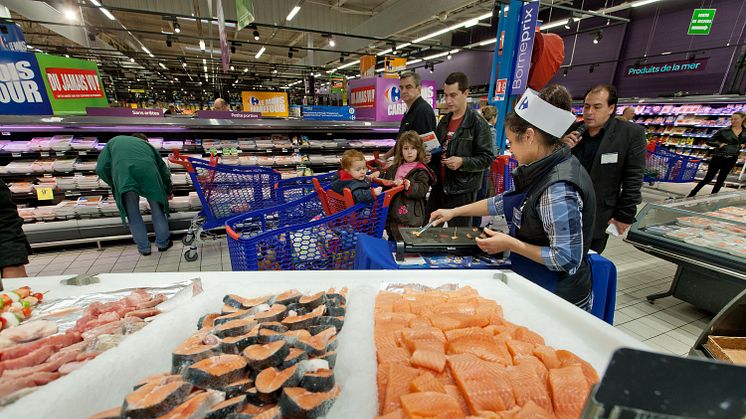
Press release -
Tremendous growth in Norwegian seafood exports
Norway exported 216,000 tonnes of seafood totaling NOK 9.3 billion in February. This is a 6 per cent reduction in volume but an increase in value of NOK 1.4 billion, or 17 per cent, compared with February last year. So far this year, 430,000 tonnes of seafood have been exported with a value of NOK 19 billion. This is a decrease of 2 per cent, while the value has increased by NOK 2.5 billion, or 15 per cent, compared with the same period last year.
“Despite increased uncertainty in the world's seafood markets as a result of the focus on Covid-19, demand for Norwegian seafood continues to increase overall. The greatest growth in value was for salmon. Salmon as a category is proving to be very robust against the temporary reduction in demand from individual markets. The reason for this is that salmon is exported to over 100 markets, used for many different occasions and is available in many product forms.
“The export of whitefish has contributed most to this month's growth and is driven by both currency and demand”, says Tom-Jørgen Gangsø, Director of Market Insight and Market Access with the Norwegian Seafood Council.
Significant increase in salmon exports
Norway exported 81,100 tonnes of salmon worth NOK 5.9 billion in February. This is an increase in volume of 1 per cent, while export value increased by NOK 817 million, or 16 per cent, compared with February last year. So far this year, 168,000 tonnes of salmon have been exported, worth NOK 12.6 billion. This is an increase in volume of 1 per cent, while the value has increased by NOK 1.9 billion, or 18 per cent. The average price for fresh whole salmon in February was NOK 68.99 per kg against NOK 58.87 per kg in February 2019. Poland, France and the United States were the largest recipients of salmon from Norway in February.
“As expected, we are seeing a sharp decline in salmon exports to China. In February, 363 tonnes of salmon were exported to China, a decline of 83 percent compared to the same period last year. Although there is a large decline, we are now seeing a gradual increase in volume”, says Paul T. Aandahl, Seafood Analyst at the Norwegian Seafood Council.
“Over the past couple of weeks we have seen cautious steps towards increased activity, which we hope will lay the foundation for increasing demand in food service and restaurants. Precautionary measures will continue to be implemented and implemented that will set the framework for trade and daily living in the time to come as the market makes its recovery”, says Victoria Braathen, Norwegian Seafood Council's fisheries envoy to China.
“Salmon that would otherwise have gone to China has been exported to other markets. For example, we see growth of 22 percent for fresh whole salmon to the United States, and to Taiwan, where exports increased by 73 percent in February”, Aandahl continues.
"We see a 14 percent decline in volume compared to February last year in Italy, which is the country most severely affected by Covid-19 in Europe," says Aandahl.
Trout exports see gains
Norway has exported 4 900 tonnes of trout worth NOK 302 million in February. Volume increased by 39 per cent, while export value increased by NOK 58 million, or 24 per cent, compared with February last year. So far this year, 10,600 tonnes of trout have been exported to a value of NOK 653 million. This is an increase in volume of 41 per cent, while the value increased by NOK 148 million or 29 per cent. Ukraine, the United States and Thailand were our largest trout markets in February.
“In the big picture, it is fresh Norwegian salmon that controls the world market price for salmon fish. However, strong growth in trout production has led to lower prices for trout than for salmon. In February, the average price for whole fresh whole trout was 8.70 lower than for salmon”, says Aandahl.
Up for fresh and frozen cod
Norway has exported 8 900 tonnes of fresh cod including skrei to a value of NOK 404 million in February. This is an increase in volume of 4 per cent, while the value increased by NOK 47 million, or 13 per cent, from February last year.
So far this year, 15,000 tonnes of fresh cod including skrei have been exported with a value of NOK 729 million. This represents an increase in volume of 13 per cent, while the value increased by NOK 147 million, or 25 per cent. Of this, 1,800 tonnes were skrei, which is a 4 per cent reduction in February. The value of skrei exports was NOK 86 million, which is at the same level as last year. Denmark, the Netherlands and Spain are the largest export markets for fresh cod in February.
“Increased export volumes are due to increased catches so far this year, compared to the previous year. As usual, we are seeing considerable volume growth from January to February, which has also led to a fall in prices. Nevertheless, prices are still higher than February last year. The weak kroner contributes to this, but there is also price inflation in the euro, which indicates a good level of demand”, says Seafood Analyst Ingrid K. Pettersen with the Norwegian Seafood Council.
In February, Norway exported 8,200 tonnes of frozen cod worth NOK 377 million. This is an increase in volume of 16 per cent, while the value increased by NOK 80 million, or 27 per cent. So far this year, 13,300 tonnes of frozen cod have been exported to a value of NOK 611 million. This is a 21 per cent reduction in volume, while the value of exports fell by NOK 80 million, or 12 per cent. China, the United Kingdom and Lithuania are the largest markets for frozen cod in February.
“For February, we see positive figures for frozen cod for China, as well as redfish and blue halibut. As a result of the current situation, there is a trend towards more home consumption of seafood products sold through retail and e-commerce. This also applies to Norwegian whitefish products, including Norwegian cod, which are increasingly popular with Chinese consumers”, says Victoria Braathen.
Growth for clipfish
Norway has exported 7,600 tonnes of clipfish worth NOK 407 million in February. Export volume fell by 17 per cent, while the value increased by NOK 25 million, or 7 per cent, compared to February last year. So far this year, 16,200 tonnes of clipfish have been exported to a value of NOK 811 million. This is a 13 per cent reduction in volume, while the value increased by NOK 20 million, or 3 per cent. Portugal, Brazil and the Dominican Republic were our most important markets in February.
“With steady volumes so far this year, along with price growth, codfish are the ones that contribute most to value growth. At the same time, some of the volume decline in saithe is offset by a significant rise in the price of saithe clipfish. Good demand in the markets is the main explanation” says Ingrid K. Pettersen.
“Clip fishing exports to Brazil have been weak for a long time - despite good demand from Brazilian consumers. The weakening Brazilian real makes imported products expensive” says Øystein Valanes, the Norwegian Seafood Council´s fisheries envoy to Brazil.
“At the same time, the Dominican Republic is developing well as a market, with both price and volume growth so far this year. The reason for this is a low supply of stockfish at the beginning of the year which is now starting to fill up.", says Valanes.
Salt fish exports fall
In February, Norway exported 2,100 tonnes of salted fish worth NOK 116 million. Export volume increased by 25 per cent, while value increased by NOK 29 million, or 34 per cent, compared with February last year. So far this year, 3,300 tonnes of salted fish have been exported to the value of NOK 177 million. This is an increase in volume of 35 per cent, while the value increased by NOK 52 million, or 41 per cent. Greece, Portugal and Spain are our most important markets in February.
Both herring and mackerel exports rise
Norway exported 38,200 tonnes of herring worth NOK 376 million in February. This represents a 3 per cent reduction in volume, while the value of exports has increased by NOK 89 million, or 31 per cent. So far this year, 73,500 tonnes of herring have been exported, worth NOK 714 million. The volume is at the same level as last year, while the value increased by NOK 142 million, or 25 per cent.
Herring catches have been of particularly good quality. The average price in February was approximately 20% higher than last year measured in USD, and when measured in Norwegian kroner, the average price this year has been almost 35 per cent higher than last year. This is due to the weakness of the Norwegian krone, says Frank Isaksen, chief analyst in the Norwegian Seafood Council.
"As a consequence of Covid-19, some logistical challenges are reported in some ports in Asia, while in other markets such as Eastern Europe and Africa there have been no such reports of disruption", says Isaksen.
Norway exported 34,000 tonnes of mackerel worth NOK 552 million in February. Volume increased by 118 per cent, while value increased by NOK 289 million, or 110 per cent. So far this year, 60,500 tonnes of mackerel have been exported to a value of NOK 991 million. This is an increase in volume of 59 per cent, while the value increased by NOK 357 million, or 56 per cent. Nigeria, China and Japan were the largest recipients of mackerel in February.
"This year's mackerel quota is 40 per cent higher than in 2019, and the relatively strong prices have probably also been the reason for so much fishing this year. The average prices in February in USD are approx. 10 per cent lower than last year, and approx. 3.5 per cent lower when measured in Norwegian kroner", says Isaksen.
Decline for prawns but an increase in the price of king crab
Norway has exported 828 tonnes of prawns worth NOK 70 million. This is a 12 per cent reduction in volume, while the value fell by NOK 12 million, or 15 per cent, compared with February 2019. Sweden, the United Kingdom and Finland were the largest export markets for prawns in February.
Norway has exported 118 tonnes of king crab worth NOK 41 million. This is a decrease of 37 per cent, while the value has fallen by NOK 16 million or 29 per cent.
South Korea, Vietnam and the United States were the largest importers of king crab from Norway in February.
"The decrease in volume is mainly due to reduced demand due to Covid-19. There will now also be a natural decrease in volume due to the shell change period. Prices in USD are up approximately 4 per cent, and when denominated in Norwegian kroner, are up by approximately 13 per cent", says Frank Isaksen, chief analysist in the Norwegian Seafood Council.
Topics
Categories
The Norwegian Seafood Council works with the Norwegian fisheries and aquaculture industries to develop markets for Norwegian seafood through local market intelligence, market development and reputational risk management. The Seafood Council is headquartered in Tromsø and maintains local representatives in twelve of Norway's most important international markets. The Norwegian seafood industry finances the activities of the Norwegian Seafood Council via a tariff on all Norwegian seafood exports.
The Norwegian Seafood Council is a public company owned by the Ministry of Trade, Industry and Fisheries.

